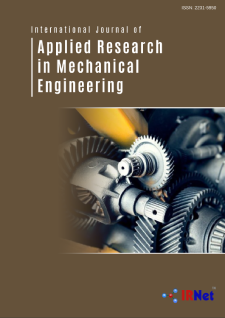International Journal of Applied Research in Mechanical Engineering IJARME
ISSN: 2231-5950

Abstracting and Indexing


IJARME
Minimization Of Rewok In Belt Industry Using Dmaic
Anup A. Junankar
Department of Mechanical Engineering, Y.C.C. Engineering College, Nagpur, India,
Abstract
The fast changing economic conditions such as global competition, declining profit margin, customer demand for high quality product, product variety and reduced lead–time etc. had a major impact on manufacturing industries. To respond to these needs a new paradigm in this area of manufacturing strategies is Six Sigma. The Six Sigma approach has been increasingly adopted world wide in the manufacturing sector in order to enhance productivity and quality performance and to make the process robust to quality variations. This paper discusses the quality and productivity improvement in a manufacturing enterprise through a case study. The paper deals with an application of Six Sigma DMAIC(Define–Measure- Analyze-Improve-Control) methodology in an industry which provides a framework to identify, quantify and eliminate sources of variation in an operational process in question, to optimize the operation variables, improve and sustain performance viz. process yield with well-executed control plans. Six Sigma improves the process performance (process yield) of the critical operational process, leading to better utilization of resources, decreases variations & maintains consistent quality of the process output.
Recommended Citation
[1] Dr. R.L. Shrivastava, K.I. Ahmad, T.N. Desai, “Engine Assembly Quality Improvement using Six Sigma”, WCE2008, July 2-4,2008,London,U.K. [2] Dr.R.L. Shrivastava, T.N. Desai, “Six Sigma- A New Direction to Quality and Productivity Management”, WCECS 2008, Oct. 22-24, 2008, San Francisco,USA [3] H. Wang, “A Review of Six Sigma Approach: Methodology, Implementation and Future Research”, Zhejiang Normal University, Jinhua City, China, pp.1-4[4] M. Hekmatpanah, M. Sadroddin, S. Shahbaz, “Six Sigma Process and its Impact on the Organizational Productivity”, World Academy of Science, Engineering and Technology-43, pp. 365-369, 2008 [5] Y.H. Kwak, F.T. Anbari, “Benefits, Obstacles and Future of Six Sigma Approach”, George Washington University, DC 20052, USA [6] J.E. Ferreira, I.S. Lopes, “Improvement of Scrap Request with Six Sigma Methodology”, WCE 2010, June 30-2 July, 2010, London, U.K. [7] Dr. Larkin Dudley, Dr. J. Wolf, “Six Sigma: A Multidimensional TQM Methodology”, V.P. Institute and State University, Washington, May 10, 2004. [8] Pande Peter S., “The Six Sigma Way”, Tata McGrawHill Edition. [9] J Antony, A. Kumar, “World Class Application of Six Sigma”, Butterworth-Heinemann Edition. [10] Sung H. Park, “Six Sigma for Quality and Productivity Promotion”, Published by The Asian Productivity Organization, Hirakawacho, Tokyo, Japan [11] K.Ketkamon, J.Teeravaraprug, “Value and Non-value Added Analysis of Incoming Order Process”, Proceedings of the International Multi Conference of Engineering and Computer Scientists, Vol. II, March2009, Hong Kong, pp.1-3, 2009 [12] http://www.spcwizard.com/calcsigma.zip [13] M.S. Raisinghani, H. Ette, R. Pierce, G.Cannon, P. Daripaly, “Six Sigma : Concept, Tools and Applications”, Industrial Management & Data Systems, Vol. 105, No.4, pp.491-505, 2005 [14] F.M. Gryna, J.A. DeFeo, “Quality Planning & Analysis for Enterprise Quality”, Tata McGraw-Hill Edition, 2008 [15] M.Mahajan, “Statistical Quality Control”, Dhanpat Rai & Co. (P) LTD., pp.186-206, pp. 272-273, 2006 [16] K. Amar, D. Davis, “A Review of Six Sigma Implementation Framework and Related Literature”, Proceedings of the International Multi Conference of Engineering and Computer Scientist, Vol. II, March2008, Hong Kong, 2008 [17] O.H. Khan, “A Study of Six Sigma Implementation and Critical Success Factor”, Pakistan’s Ninth International Convention on Quality Improvement, Karachi, Pakistan, pp. 1-12, Nov. 2005 [18] Dr. J. Antony, M. Bhaiji, “Key Ingredients for a Successful Six Sigma Program”, Warwick Manufacturing Group School of Engineering, University of Warwick, UK [19] R. Dian M, Amrin Rapi, “The Measurement of Quality Performance with Sigma Measurement and Cost of Poor Quality as a Basis for Selection Process of Quality Improvement”, Proceedings of the International Multi Conference of Engineering and Computer Scientist, Vol. III, March-2010, Hong Kong, 2008 International Journal of Appli